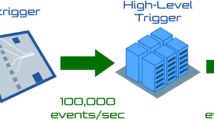Abstract
Current research in experimental particle physics is dominated by high profile and large scale experiments. One of the major tasks in these experiments is the selection of interesting or relevant events. In this paper we propose to use statistical classification algorithms for this task. To illustrate our method we apply it to an Monte-Carlo (MC) dataset from the BaBar experiment. One of the major obstacles in constructing a classifier for this task is the imbalanced nature of the dataset. Only about 0.5% of the data are interesting events. The rest are background or noise events. We show how ROC curves can be used to find a suitable cutoff value to select a reasonable subset of a stream for further analysis. Finally, we estimate the CP asymmetry of the \({B}^{\pm }\rightarrow D{K}^{\pm }\) decay using the samples extracted by the classifiers.
Access this chapter
Tax calculation will be finalised at checkout
Purchases are for personal use only
Similar content being viewed by others
References
Boutigny D, et al. (1994) Letter of intent for the study of CP violation and heavy flavor physics at PEP-II. SLAC-0443
Breiman L (2001) Random forests. Mach Learn 45:5–32
Breiman L, Friedman J, Olshen R, Stone C (1984) Classification and regression trees. Wadsworth and Brooks, Monterey, CA
Freund Y, Schapire R (1996) Experiments with a new boosting algorithm. In: Machine Learning: Proceedings of the Thirteenth International Conference, Morgan Kauffman, San Francisco, pp 148–156
Griffiths D (1987) Introduction to elementary particles. Wiley, New York, USA
Karbach TM (2009) Measurement of CP parameters in B − > D CP ± 0 K decays with the BABAR detector. PhD thesis, TU Dortmund, http://hdl.handle.net/2003/26523
Nelder JA, Wedderburn RWM (1972) Generalized linear models. J Royal Stat Soc A 135:370–384
Acknowledgements
This work was partly supported by the Collaborative Research Center SFB 823 and the Research Training Group “Statistical Modelling” of the German Research Foundation. Due to the computationally intensive nature of this case study, all calculations were performed on the LiDO HPC cluster at the TU Dortmund. We would like to thank the LiDO team for their support.
Author information
Authors and Affiliations
Corresponding author
Editor information
Editors and Affiliations
Rights and permissions
Copyright information
© 2012 Springer-Verlag Berlin Heidelberg
About this paper
Cite this paper
Weihs, C. et al. (2012). A Case Study on the Use of Statistical Classification Methods in Particle Physics. In: Gaul, W., Geyer-Schulz, A., Schmidt-Thieme, L., Kunze, J. (eds) Challenges at the Interface of Data Analysis, Computer Science, and Optimization. Studies in Classification, Data Analysis, and Knowledge Organization. Springer, Berlin, Heidelberg. https://doi.org/10.1007/978-3-642-24466-7_8
Download citation
DOI: https://doi.org/10.1007/978-3-642-24466-7_8
Published:
Publisher Name: Springer, Berlin, Heidelberg
Print ISBN: 978-3-642-24465-0
Online ISBN: 978-3-642-24466-7
eBook Packages: Mathematics and StatisticsMathematics and Statistics (R0)




